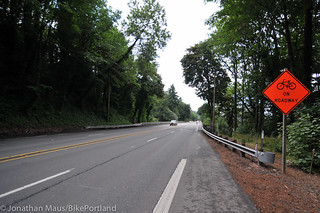The Oregon Department of Transportation brushed aside proposals to allow safe bike travel on Southwest Barbur Boulevard, raising the possibility of “unacceptable impacts” that might result from replacing a northbound travel lane with dedicated bike lanes.
“While some have framed the removal of a motor vehicle lane on the bridges as a quick and easy, ‘noimpact’ solution, there are impacts that need to be considered,” the agency wrote in a memo distributed Thursday evening.
The memo cited estimates that removing one of Barbur’s four travel lanes would increase northbound auto travel times between 5 and 15 percent today, and somewhere between 10 and 65 percent by 2035.
During the busiest few minutes of the morning on the 4.9 mile corridor in question, it comes out to an additional delay of somewhere between 84 seconds and 9 minutes over the course of the next 22 years.
Update 8:03 pm: I’ve changed these figures (previously 1.8 miles and 36 seconds to 4 minutes) to include the full stretch of road studied and to allow an apples-to-apples comparison of travel times in 2035. -MA
“The actual amount of delay would likely fall somewhere in between these two predictions on ‘typical’ travel days,” the memo from ODOT’s Jessica Horning explained.
Barbur currently forces cars and bikes to merge into the same lane as they cross two narrow bridges on Barbur. The speed limit on the bridges is 45 mph.
“Over the past several months, ODOT has received both strong messages of support for a road diet,” Horning wrote, “and strong objections from stakeholders who feel that reducing motor vehicle capacity on Barbur/99W would create unacceptable impacts for commuters, businesses, transit, and freight operations.”
ODOT spokesman Don Hamilton said Tuesday that he didn’t know if ODOT’s traffic models accounted for any reduced auto traffic that might result from turning Barbur into the only safe and comfortable bikeway between Southwest Portland’s 60,000 residents and the rest of the city.
“That’s a good question,” Hamilton said. “I’m not sure.”
Update 6:34 pm: According to files provided by Hamilton, the traffic model used by ODOT that found the 65 percent increase assumes that the ratio of people driving, biking and taking transit would be unchanged both by bike improvements and by increased congestion, and that people would not readjust their schedules to avoid congestion.
Two weeks ago, ODOT wrote in a press release that “traffic will not be significantly impacted” by the temporary removal of two motor vehicle lanes on the bridges, “especially over time as motorists adapt to the changes.”
The memo released Thursday night also estimated that “a significant amount of traffic (5-20% of vehicles today, and 10-35% in 2035)” would “divert to local streets such as Corbett, Terwilliger, Capitol Hill, and Taylor’s Ferry.” It did not discuss the possibility of other measures, such as speed bumps or traffic diverters, that might limit such diversion.
Hamilton said such measures were outside the scope of ODOT’s study.
“This was designed to understand what a road diet would affect,” Hamilton said.
He added that “any suggestion that we ignore bike and pedestrian needs is incorrect.” ODOT is planning to install a flashing “bikes on bridge” sign and to reconsider bike improvements as part of the Southwest Corridor planning process that’s expected to wrap up in the mid-2020s at the soonest, though changes to bike facilities might happen earlier in that process.
“This is an area that is ripe for improvement, and it’s getting some serious attention,” Hamilton said.
Horning, who works a 4/10 schedule, was unavailable for comment Friday.


